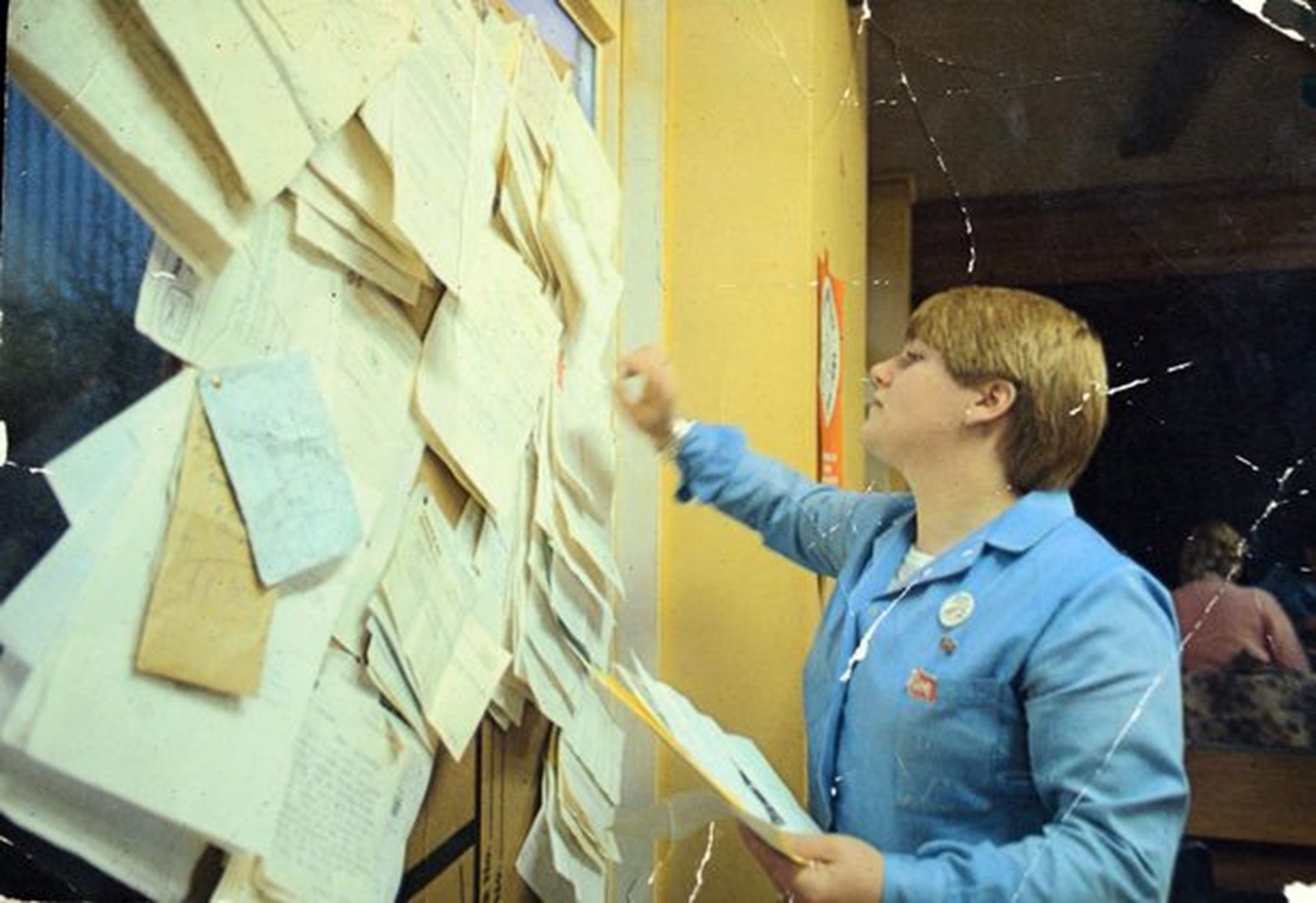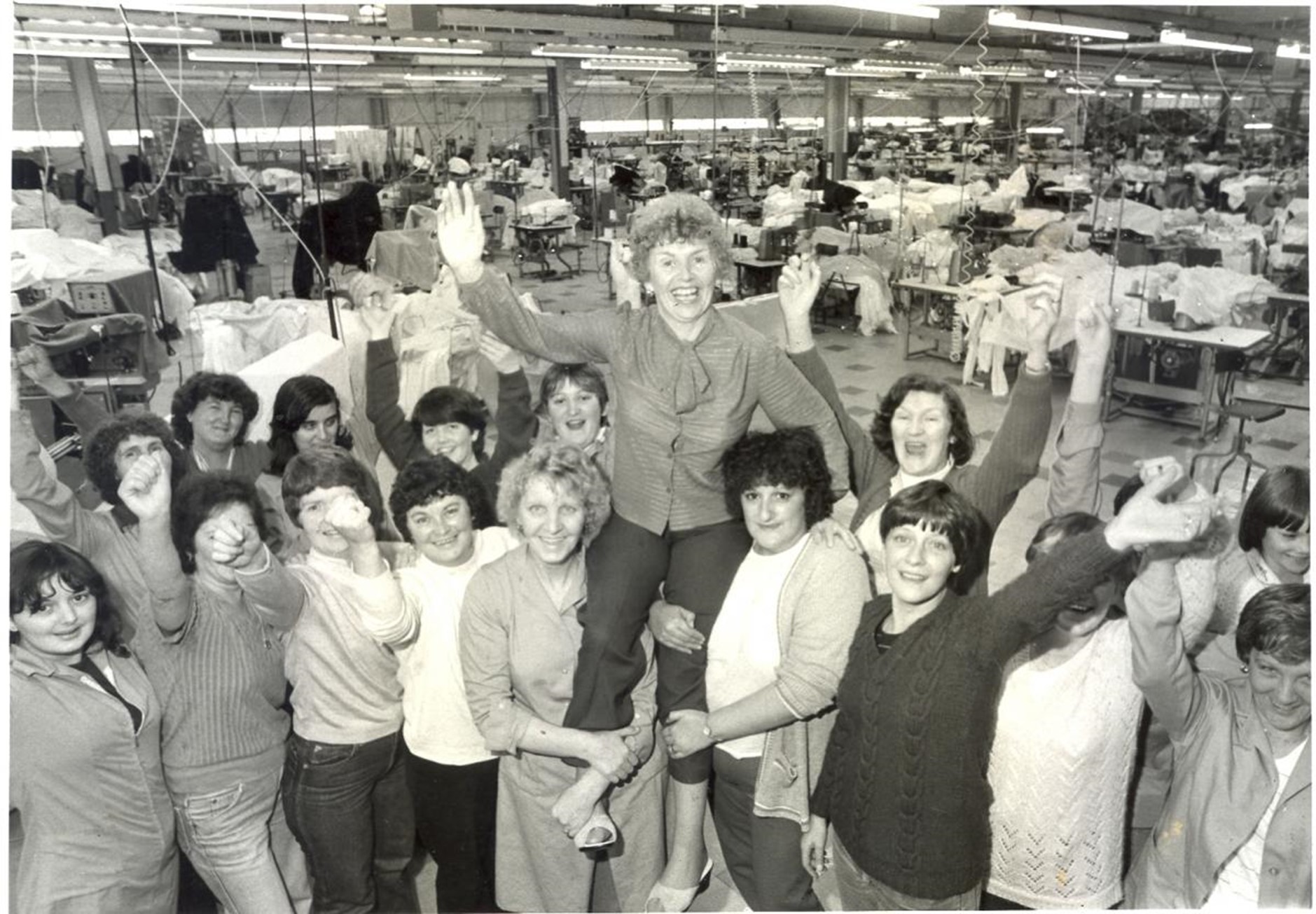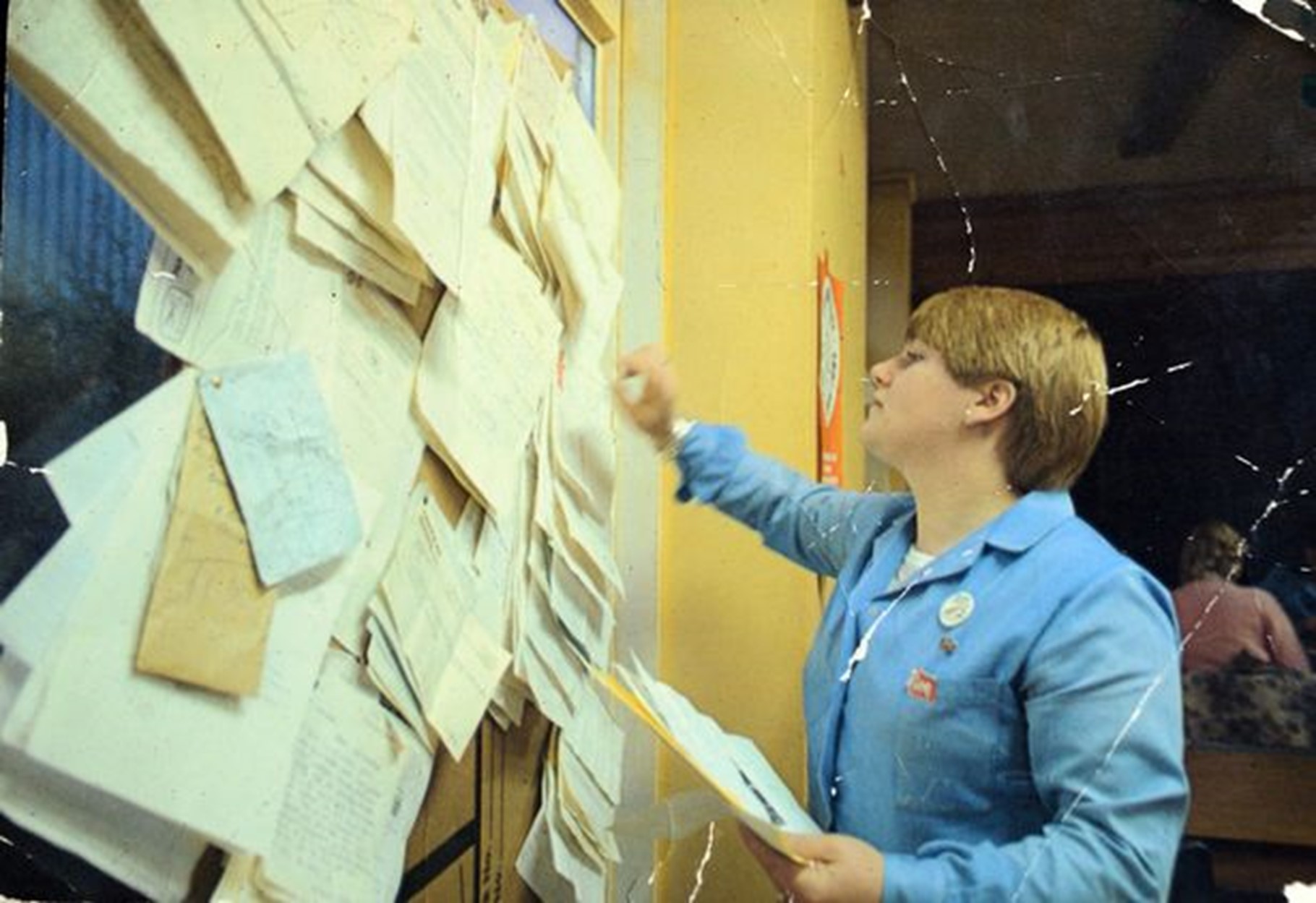Find out more about The Open University's Social Sciences courses
This article belongs to the Women and Workplace Struggles: Scotland 1900-2022 collection.

Between February and August 1981, the mostly women workers at Greenock’s Lee Jeans factory defied management intentions to close the plant. At a time when female unemployment in Greenock was 50% higher than in Scotland as a whole, the women argued that their factory was feasible and that corporate greed was the reason for closure. They seized control of the site, and occupied the premises to prevent the removal of stock and machinery. Following a seven-month struggle, the workers were vindicated; the factory was bought by new owners, and the women returned to their sewing machines for the new firm, ‘Inverwear Limited’. In this piece, I interrogate archive materials, and oral history interviews I conducted with workers between 2014 and 2016, in order to understand the development of the occupation and its legacies.
The Changing Economy of Greenock and Inverclyde
The Lee Jeans plant was operated by Vanity Fair Co. (VF Corporation), a large, American-based, multinational clothes manufacturer. By 1972, Lee was their most successful brand, representing almost two-thirds of their $297 million sales. In 1970, they opened their first factory on mainland Britain, in Greenock, Inverclyde, 25 miles down the River Clyde from Glasgow.
Greenock, historically a town of ‘sugar and ships’, had been suffering from the fallout of deindustrialisation throughout the post-Second World War era. These issues led to Inverclyde being designated a Development District in 1960, being an area where high rates of unemployment would persist without government intervention.

'The town of sugar and ships'. The former sugar landing sheds at Greenock's James Watt Dock stand under the giant cantilever crane, one of four remaining on the River Clyde. January 2022. Picture by Thomas Smillie Photography.
Being a Development District meant there was a range of financial incentives for firms to open in the area. VF were more than grateful for these. They received free rent and rates in their first three years in Greenock, and paid half rent and rates for the following three. The government paid 40 per cent towards machinery, and they received a premium of £2 per worker per week. After opening, employment in Greenock’s Lee Jeans factory rose to 240, the majority of whom were women sewing machinists.
Despite the availability of government assistance, the economic situation in Greenock continued to deteriorate. Between 1976 and 1980, 4,580 redundancies were notified in the area and, by 1981, there were 18 unemployed people for every job advertised. Female unemployment was 13.3 per cent, fifty per cent higher than the Scottish figure of 9.6 per cent. It was within this context of decline that the Lee Jeans workers were told that their factory would close, and they would join the increasing number of Greenockians searching for the rapidly decreasing number of available jobs.
Factory Closure and Occupation
During annual negotiations over pay in January 1981, Helen Monaghan – the workers’ Shop Steward – was told that the factory would close. The reasons given were the rising value of the pound and the unprofitability of the plant. Helen believed that these were excuses for VF’s primary goal – relocation for new subsidies and increased profits. Along with an official from the workers’ union, the National Union of Tailor and Garment Workers (NUTGW), Helen provided a range of proposals to prevent closure. She explained that:
We offered tae dae a three day [week]… Well, if we dae a three-day week, things should pick up an’ oor jobs, at least oor factory’s still here and we can work. We had tae put aw’ these things in, because eh, ye wurnae gonnae gie up, and obviously it wis tryin’ them.
A week later, on 5 February 1981, local management informed Helen that the company had rejected their proposals. The factory would close as planned.
Once this decision had been made, Helen gathered the workers in the canteen to explain what was happening. The workers were faced with two choices: to accept redundancy, or to resist closure through taking control of the plant. The workers voted, by majority, to occupy the factory. The Lee Jeans sit-in began immediately.
There were no prior-made plans to occupy, and the 240 workforce had gone to the factory as normal that morning. The first objective was to inform family members that they would not be home that night, which ultimately led to the payphone being jammed due to overuse. There were no provisions for food, and the factory canteen was closed. This resulted in a group of workers, led by Maggie Wallace, scaling down from a roof window to head off and source 240 fish suppers. There were no sleeping arrangements, with those who could sleep dossing down wherever was suitable.
Even at this point, the workers did not feel that their struggle would be a long one. All of the workers I interviewed in 2014-16 recalled their belief that, after giving Vanity Fair a fright, they would return to work as normal. Indeed, on the first day, Helen refused to speak to any media, not wanting to be in the spotlight for an event that would be over so soon. However, it rapidly became apparent that VF would not negotiate; the factory would shut as planned.

Catherine Robertson inspects assorted paperwork during the Lee Jeans Occupation, 1981.
Once this became clear, the sit-in became more organised. Workers were split into shifts, ensuring the plant was occupied at all times, and that workers could get sufficient time off. Local management agreed to open the canteen if Helen would keep workers off of the main factory floor, a decision she recalls as being ‘the worst thing he could’ve did’, because the workers were then able to prepare meals, a crucial aspect in a prolonged occupation. Some workers did leave to find alternative employment, but the majority remained embedded in the factory for seven months.
The NUTWG and the Lee Jeans Sit-in
The occupation was decided immediately by a show of hands. As a result, it didn’t begin as an official NUTGW dispute, as their internal processes had not been followed. The union’s hierarchy were uncomfortable with the action being taken by the rank-and-file in Greenock. Letters were sent to their headquarters in London, imploring them to officially recognise the dispute; but the union held firm. They argued that they could not recognise the action until they had sought legal advice. However, documents held at the Working-Class Movements Library in Salford, demonstrate that they had received this advice early in the dispute, and their legal advisors believed the sit-in was legal. After the workers had been in occupation for six weeks, the union finally relented, and asked for a formal ballot to be cast among the workers; 97 per cent voted in favour of continuing the dispute.
Despite recognising the action, the union remained less than supportive of the sit-in. Helen was ‘summoned’ to London to speak with General Secretary Alec Smith. He offered a caravan to allow them to end the occupation of the plant, and picket outside instead; Helen refused the offer. On 30 June, the NUTGW withdrew their support, and the sit-in once again became an unofficial dispute. This decision – along with their initial reluctance to support the workers – led to widespread condemnation. From within the membership, a letter to the Executive Board stated that:
I as a member and elected representative of this union N.U.T.G.W am sick and disgusted to learn of you withdrawing support so desperately needed in the VF dispute… it is not only myself asking this question but my workmates too. To say you have dashed the hopes of every worker in this industry must be a great understatement.
In our interview, former Lee worker Tricia Arkley reflected furiously that:
Ah wis ragin’. Oh ah called [union official] for everythin’… ah called him aw’ the bastards under the sun… That’s the only time ah ever remember bein’ angry durin’ the whole time, wis when we were told the Tailor and Garment Workers had walked oot an’ left us, abandoned us.
The sense of abandonment among the workers ensured that, when the factory reopened, they moved membership to the Transport and General Workers Union (TGW).
Support from the Labour Movement
In contrast to the approach of the NUTGW, the workers at Greenock received phenomenal support from rank-and-file trade unionists, locally and nationally. As soon as the sit-in began, local shipbuilders agreed a levy of 50p per worker, per week, for the duration of the dispute. They were followed by workers at other workplaces on Clydeside, such as Upper Clyde Shipbuilders in Glasgow, Talbot car plant in Linwood, Rolls Royce in Glasgow, and a host of others. Workers travelled across the UK, explaining their struggle and seeking support. Financial support was so extensive that, after the action ended, the workers used leftover monies to establish a solidarity fund for other workers taking action. Support was not only financial; on the planned closure date, over 200 local shipbuilders picketed the plant to oppose any possible forcible removal. The occupation became a cause celebre of the labour movement, with national Labour figures like Tony Benn and Michael Foot visiting to offer solidarity. This support was crucial in ensuring the success of the action, particularly due to the NUTGW’s lack of assistance.
Ending of Dispute
On 24 August, the Greenock Telegraph front page exclaimed ‘Jeans Jobs Saved!’ After seven months of 24-hour occupation, VF had agreed to sell the plant to local management for an undisclosed fee, believed to be significantly below the initial asking price. In September, the workers returned to their machines and began production for Inverwear Ltd. The factory would ultimately close for good a few years later, following the collapse of two key customers. However, through their occupation, the Lee Jeans workers demonstrated the power of working-class activism in opposing the unjust decisions of multinational corporations. Their action would serve as inspiration for other Scottish women facing closure in the period of accelerated deindustrialisation in Scotland.

With victory secured, Lee Jeans workers hold shop steward Helen Monaghan aloft in celebration, August 1981.




Rate and Review
Rate this article
Review this article
Log into OpenLearn to leave reviews and join in the conversation.
Article reviews
I was very pleased, and to be honest, a little surprised to see a few sentences of Scots writing reflecting the language used by the quoted Helen.
It's a small thing, but to see a faithfull reflection of how we actually speak is rare, particuarly in journals or academic spaces.